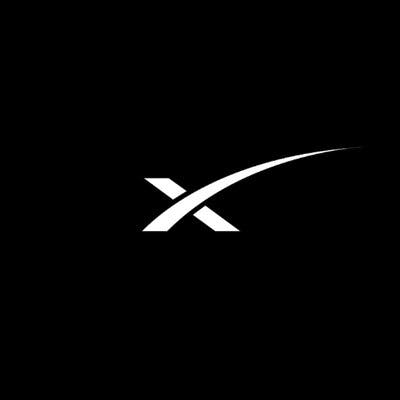
Revenue
$14.20B
2024
Valuation
$360.00B
2024
Growth Rate (y/y)
63%
2024
Funding
$9.74B
2024
Revenue
Sacra estimates SpaceX hit $14.2B in revenue in 2024, representing 63% growth from $8.7B in 2023. The company achieved profitability in Q1 2023 with $55M in profit on $1.5B in revenue.
Starlink has become SpaceX's largest revenue stream, generating $7.7B in 2024 (up 83% YoY), comprising 58% of SpaceX's total revenue of $14.2B. Since launching in beta with 10,000 users in 2021, the service has grown to 1M users in 2022, 2.3M in 2023, and 4.6M in 2024. Residential customers represent 4.4M subscribers with ~$2,000 ARPU, though this segment's 0.2% market share remains its lowest.
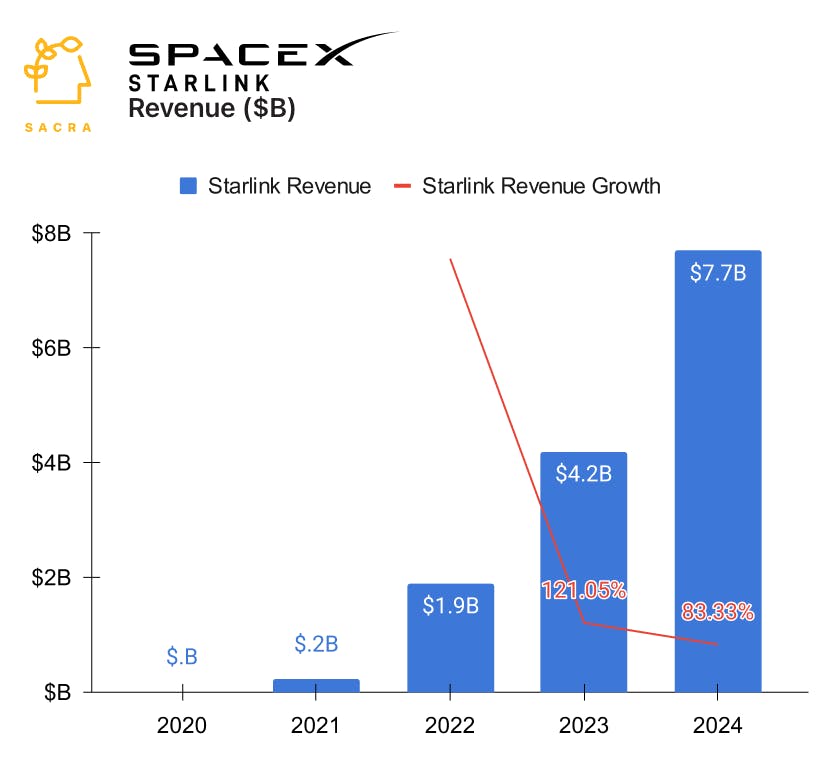
Launch services revenue reached $3.5B in 2023, driven by 28 Falcon 9 launches ($62M each) and 5 Falcon Heavy launches ($125M each). Commercial launches contributed roughly $800M, while three crewed missions generated approximately $780M.
Starlink's network performance significantly outpaces competitors, delivering speeds up to 215 Mbps compared to Viasat's 20 Mbps. While Viasat and Intelsat serve ~7,000 combined aircraft, Starlink is rapidly gaining market share in valuable segments like maritime (~$34,000 ARPU, 0.7% market share) and aviation (~$300,000 ARPU, 0.7% market share).
Valuation
SpaceX reached a valuation of $350 billion in December 2024 through an internal tender offer, surpassing the combined market caps of Boeing ($94B) and Lockheed Martin ($144B). The company has raised $9.74 billion in total funding since its founding in 2002.
Elon Musk maintains majority ownership with a 54% stake. Other significant investors include Founders Fund (10.4%), Fidelity Investments (10.2%), and Google Ventures (7.5%). The company's most recent primary funding round in early 2023 raised $750 million at a $137 billion valuation.
At its December 2024 valuation of $350B, SpaceX is valued at 24.6x its projected 2024 revenue of $14.2B.
Product
SpaceX was founded in 2002 by Elon Musk with the initial goal of reducing space transportation costs to enable the colonization of Mars. The company began by developing its first orbital rocket, the Falcon 1, from scratch.
SpaceX found product-market fit as a low-cost satellite launch provider for NASA and commercial satellite operators, offering reliable access to space at a fraction of incumbent prices through innovative reusable rocket technology. The breakthrough came in 2008 when NASA awarded SpaceX a $1.6 billion contract for cargo resupply missions to the International Space Station.
The company's core product is its launch service, centered around the Falcon 9 rocket - a two-stage vehicle capable of delivering payloads to various orbits while landing its first stage for reuse. Customers book launches years in advance, providing detailed mission requirements for their satellite or cargo payload. SpaceX handles all aspects of launch operations, from payload integration to mission control.
This launch capability enabled SpaceX to develop Starlink, a satellite internet constellation providing high-speed broadband to users worldwide. The Dragon spacecraft rounds out SpaceX's product line, providing cargo and crew transportation to the International Space Station. All three systems - Falcon 9, Dragon, and Starlink - share common technology and manufacturing processes, creating an integrated space transportation and communications platform.
Launch services
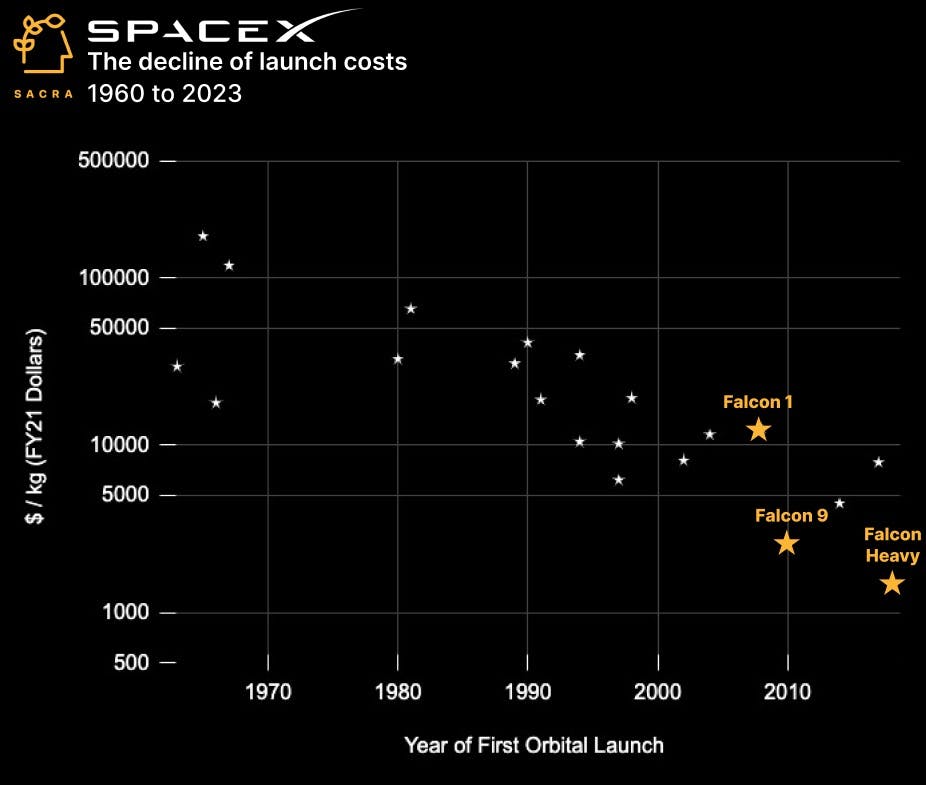
SpaceX revolutionized the launch industry by achieving 5-10x lower cost per ton than competitors through its reusable Falcon 9 rocket, which has completed over 260 successful re-flights out of 315 total launches, allowing the company to amortize the $62M launch cost across multiple missions while maintaining a >99% success rate.
This cost advantage has not only made SpaceX the dominant launch provider with ~66% of NASA's launches, but enabled the company to self-fund its Starlink constellation deployment through 63 dedicated launches in 2023 alone, while still serving 28 commercial and government launches that year.
SpaceX's entry into the launch market in 2002 challenged United Launch Alliance's (ULA) effective monopoly on U.S. government launches, where the Boeing-Lockheed Martin joint venture's reliance on 1,200+ subcontractors and specialized components had driven the cost of launching satellites to over $400M per mission.
By vertically integrating 70% of Falcon 9 production in-house at its Hawthorne facility and using commercial-grade components that met low Earth orbit requirements, SpaceX reduced costs dramatically—for example, replacing a $100,000 industry-standard radio with a $5,000 commercial alternative—while maintaining reliability through iterative design improvements that culminated in their first NASA contract in 2006.
Starlink
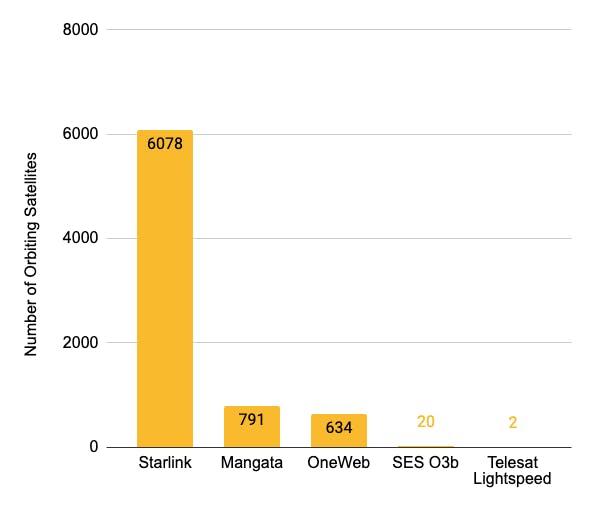
Starlink, SpaceX's satellite internet division launched in 2021, has rapidly grown from 10,000 beta users to 4.6M subscribers in 2024, leveraging SpaceX's reusable rockets and manufacturing capabilities to deploy over 6,000 low Earth orbit satellites that deliver high-speed internet to residential, maritime, and aviation customers.
While traditional satellite providers like Viasat and Intelsat serve specific market niches with geostationary satellites offering speeds of ~20 Mbps, Starlink's constellation provides lower latency (25-60ms) and faster speeds (up to 215 Mbps), enabling streaming, gaming and video calls that were previously impossible via satellite.
Starlink's competitive advantage stems from its novel satellite architecture, where thousands of small satellites in low Earth orbit (342 miles up) communicate via laser links to form a mesh network, enabling data to travel through space at the speed of light rather than bouncing between ground stations like traditional satellite systems.
The constellation's density and interconnectedness allows Starlink to serve up to 4,000 customers per satellite with download speeds of 215 Mbps, while its $600 user terminals (down from $3,000 at launch) automatically track overhead satellites using a phased array antenna that can switch connections in milliseconds as satellites pass overhead.
Starlink's business model has evolved from simple residential internet ($110/month) to a multi-tiered offering spanning consumer, enterprise and government segments, with premium services like Maritime ($250/month) and Aviation ($25,000/month) driving higher ARPU, while partnerships with major airlines like United (350 planes by 2025) and mobile carriers like T-Mobile validate the technology and expand distribution.
Business Model
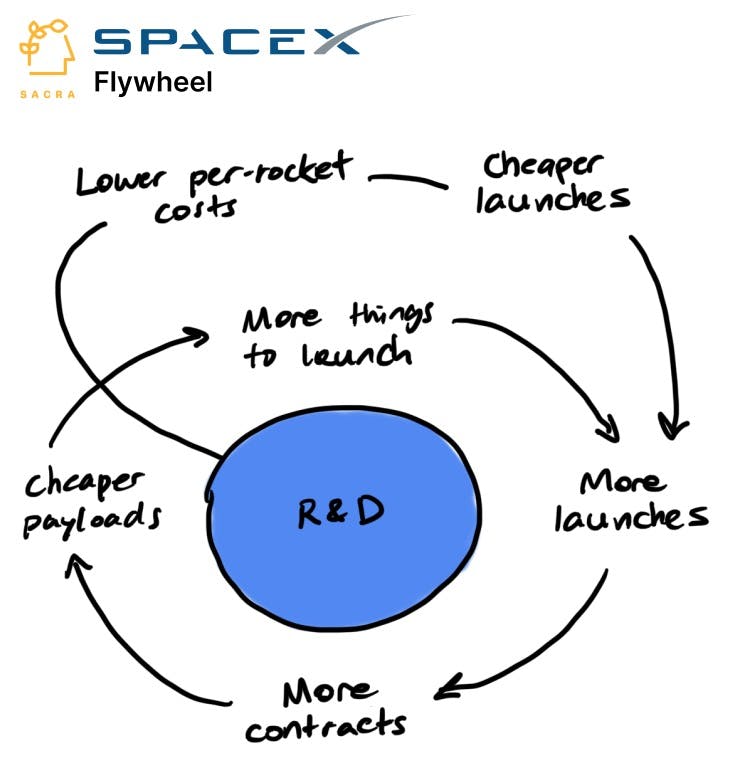
SpaceX’s key early insight was that it could use launch services (provided both to governments and commercial enterprises) as a revenue-generating engine to finance their larger vision of building increasingly advanced spacecraft capable of cheaper and more frequent trips into space.
SpaceX's business model operates as a self-reinforcing flywheel where launch services revenue ($5.5B in 2024) funds R&D for increasingly advanced reusable spacecraft, which in turn enables cheaper launches and the deployment of new revenue streams like Starlink ($7.7B in 2024), now generating 58% of total revenue with higher margins than the launch business.
The cash flow from bringing countries’ and other companies’ satellites into space—$10-$12 million per launch for the early Falcon 1 launches—saved SpaceX in its early days when it looked like a succession of mission failures might destroy the company. Today, the standard commercial Falcon 9 launch costs roughly $60M, while Falcon Heavy launches cost about $125M each.
For now, SpaceX has the luxury of setting prices based on the next-best alternative versus its own operational costs—a model which allows SpaceX healthy profit margins.
Vertical integration
SpaceX's manufacturing approach stands in stark contrast to traditional aerospace companies, with its 1-million-square-foot Hawthorne facility producing everything from Merlin engines to flight computers, while competitors like United Launch Alliance rely on complex networks of 1,200+ suppliers that drive up costs and slow innovation.
This vertically-integrated manufacturing model has allowed SpaceX to dramatically reduce component costs—for example, producing onboard radios for $5,000 versus the industry standard $100,000—while enabling rapid design iterations and quality control that helped achieve their 99% launch success rate across 315 missions.
SpaceX's vertical integration strategy extends beyond just manufacturing, with the company controlling its entire value chain from rocket design and production (70% in-house) to launch operations, ground station networks, and even operating its own spaceports in Texas and Florida.
This end-to-end control has allowed SpaceX to reduce a typical satellite launch cost from $400M to $62M, while enabling unique capabilities like recovering rockets on autonomous drone ships and developing proprietary technologies like the Raptor engine, which costs $1M compared to competitors' $20M+ engines.
TAM Expansion
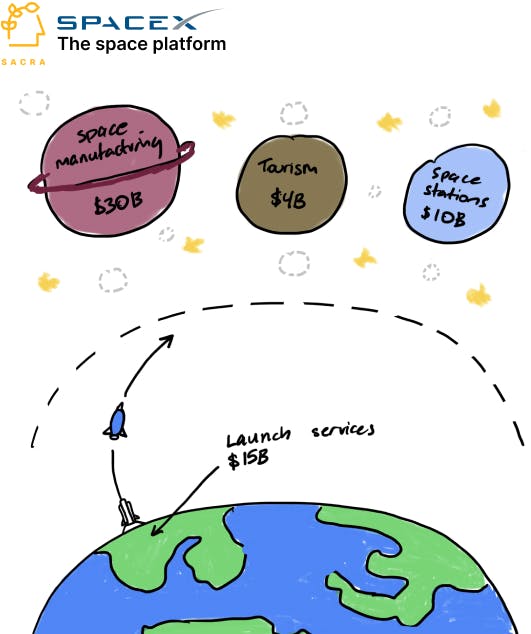
The coming commodification of launch services means that the real exciting long-term vision of SpaceX hinges on what be done with a cost-efficient, reusable platform in space.
The total size of the space economy has been estimated at roughly $400B to $500B as of 2023, and it’s expected to grow to at least $1T by the year 2030.
SpaceX, knowing that competition will drive down the margins on launch services much as it did in passenger air travel, is already thinking about how it can own a larger slice of that space economy and build more recurring revenue businesses that can generate higher-margin cashflow over the long-term. Starlink is their first play in this direction—but there will be more businesses to come in the future.
Space manufacturing
By lowering the cost per kilogram to low Earth orbit, SpaceX opens up new possibilities for potentially highly valuable space manufacturing.
Space manufacturing is compelling because certain kinds of materials can only be produced in microgravity conditions—by reducing the cost to launch into space, SpaceX has made it so that raw materials and machinery can be sent to space, with finished goods brought back to Earth, at a cost that makes the whole operation financially viable.
A few examples of the kinds of products that could be lucrative to produce in space include:
Pharmaceuticals: Gravity can cause impurities in certain drugs unless they are produced in vacuums, making their manufacture on Earth expensive. The market for drugs produced in space is projected to hit $10B by 2030.
ZBLAN fiber optic cables: ZBLAN fibers, which are far easier to produce in microgravity, are used in high-precision applications like spectroscopy and laser power due to their higher bandwidth and far superior transmittance. The market for their manufacture is expected to hit $12B by 2025.
Silicon wafers: Silicon wafers for the construction of computer chips are significantly easier to produce in high quality in microgravity, thanks to the way that it prevents defects from forming. The global market for silicon wafers was around $93 billion in 2020 and is expected to surpass $150B by 2025.
Space tourism
Space tourism is gradually becoming a feasible market, and SpaceX could play a significant role in its development. The market currently offers a variety of experiences, ranging from Earth-based activities to suborbital and orbital flights. The cost has typically been the major barrier, with experiences like Virgin Galactic's costing hundreds of thousands of dollars, but SpaceX has the opportunity to bring costs down and make space tourism more commonplace.
SpaceX's reusable technology could be instrumental in reducing costs. Estimates put the value of the global space tourism market at about $870M in 2022 and project it to grow to almost $4B in 2032 with a CAGR of 16%.
Space stations
The International Space Station (ISS), governed by a multinational treaty, has been a cornerstone for space activities since its inception. With the ISS nearing the end of its functional lifespan, a vacancy in low Earth orbit (LEO) platforms is imminent. This presents an opportunity for private entities like SpaceX to fill the gap.
In 2021, the U.S. budget for the ISS, including launch costs, was $2.9 billion. NASA has also projected a budget of over $9 billion through 2025 for crewed missions to the ISS. It is clear that the demand for a LEO platform remains substantial.
The cooperating agencies on the ISS currently spend approximately $4.5 billion per year, with half allocated for productive missions and the other half for operations and maintenance. Given the nearing decommissioning of the ISS, this spending could potentially be redirected toward new platforms.
SpaceX, with its experience in orbital technology and a focus on reusability, is well-positioned to provide a solution. The company could capitalize on this opportunity by developing its own LEO platforms, potentially securing a share of the budgets that have historically been directed towards ISS operations.
Risks
Capital risks: SpaceX faces significant capital risk due to its massive infrastructure investments, with CEO Elon Musk warning in late 2023 about "genuine risk of bankruptcy" if the company couldn't achieve a Starship flight rate of at least once every two weeks, highlighting how the capital-intensive nature of developing next-generation rockets and maintaining a 6,000+ satellite constellation requires consistent operational execution to avoid financial distress
Competition risk: While SpaceX currently dominates the launch market with its reusable Falcon 9 technology, emerging competitors like Blue Origin (developing the reusable New Glenn rocket), China's Long March series (156 launches in 2023), and Rocket Lab (targeting 15% lower costs than Falcon 9 with its Neutron rocket) threaten to erode SpaceX's cost advantages.
In the higher-margin Starlink business, competition is intensifying as Amazon's Project Kuiper plans to launch 3,236 satellites by 2029 backed by a $10B investment, China's Guowang constellation aims for 13,000 satellites, and the European Union's sovereign Iris² network targets 170 satellites by 2027—all while traditional players like Viasat ($1.12B Q3'24 revenue) and Intelsat ($2.1B 2023 revenue) expand their hybrid LEO-GEO networks.
Funding Rounds
|
|
|||||||||
|
|||||||||
|
|
|||||||||
|
|||||||||
|
|
|||||||||
|
|||||||||
|
|
|||||||||
|
|||||||||
|
|
|||||||||
|
|||||||||
|
|
|||||||||
|
|||||||||
|
|
|||||||||
|
|||||||||
|
|
|||||||||
|
|||||||||
|
|
|||||||||
|
|||||||||
|
|
|||||||||
|
|||||||||
|
|
|||||||||
|
|||||||||
|
|
|||||||||
|
|||||||||
|
|
|||||||||
|
|||||||||
|
|
|||||||||
|
|||||||||
| View the source Certificate of Incorporation copy. |
News
DISCLAIMERS
This report is for information purposes only and is not to be used or considered as an offer or the solicitation of an offer to sell or to buy or subscribe for securities or other financial instruments. Nothing in this report constitutes investment, legal, accounting or tax advice or a representation that any investment or strategy is suitable or appropriate to your individual circumstances or otherwise constitutes a personal trade recommendation to you.
This research report has been prepared solely by Sacra and should not be considered a product of any person or entity that makes such report available, if any.
Information and opinions presented in the sections of the report were obtained or derived from sources Sacra believes are reliable, but Sacra makes no representation as to their accuracy or completeness. Past performance should not be taken as an indication or guarantee of future performance, and no representation or warranty, express or implied, is made regarding future performance. Information, opinions and estimates contained in this report reflect a determination at its original date of publication by Sacra and are subject to change without notice.
Sacra accepts no liability for loss arising from the use of the material presented in this report, except that this exclusion of liability does not apply to the extent that liability arises under specific statutes or regulations applicable to Sacra. Sacra may have issued, and may in the future issue, other reports that are inconsistent with, and reach different conclusions from, the information presented in this report. Those reports reflect different assumptions, views and analytical methods of the analysts who prepared them and Sacra is under no obligation to ensure that such other reports are brought to the attention of any recipient of this report.
All rights reserved. All material presented in this report, unless specifically indicated otherwise is under copyright to Sacra. Sacra reserves any and all intellectual property rights in the report. All trademarks, service marks and logos used in this report are trademarks or service marks or registered trademarks or service marks of Sacra. Any modification, copying, displaying, distributing, transmitting, publishing, licensing, creating derivative works from, or selling any report is strictly prohibited. None of the material, nor its content, nor any copy of it, may be altered in any way, transmitted to, copied or distributed to any other party, without the prior express written permission of Sacra. Any unauthorized duplication, redistribution or disclosure of this report will result in prosecution.